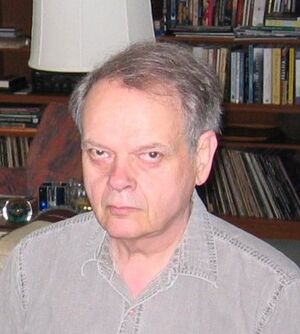John C. Reynolds facts for kids
Quick facts for kids
John C. Reynolds
|
|
|---|---|
 |
|
| Born |
John Charles Reynolds
June 1, 1935 United States
|
| Died | April 28, 2013 (aged 77) |
| Education | Purdue University Ph.D., Harvard University (1961) |
| Known for | continuations, definitional interpreters, defunctionalization, Forsythe, Gedanken language, intersection types, polymorphic lambda calculus, relational parametricity, separation logic, ALGOL |
| Awards | Lovelace Medal (2010) |
| Scientific career | |
| Fields | Computer scientist |
| Institutions | Syracuse University Carnegie Mellon University |
| Thesis | Surface Properties of Nuclear Matter (1961) |
| Doctoral students | Benjamin C. Pierce |
John Charles Reynolds (born June 1, 1935 – died April 28, 2013) was an American computer scientist. He was a very important person in the world of computer programming. He helped create new ways for computers to understand and process information. His work made computer languages more powerful and easier to use.
Contents
John Reynolds's Education and Career
John Reynolds went to Purdue University for his studies. Later, he earned a special advanced degree called a Doctor of Philosophy (Ph.D.) in theoretical physics from Harvard University in 1961.
After his studies, he became a professor.
- From 1970 to 1986, he taught information science at Syracuse University.
- After that, he moved to Carnegie Mellon University. He was a professor of computer science there until he passed away.
He also visited and taught at other famous universities around the world. These included Aarhus University in Denmark, The University of Edinburgh in Scotland, and Imperial College London in England. He also spent time at Microsoft Research in Cambridge, UK.
What John Reynolds Studied
John Reynolds was most interested in how to design programming languages. These are the special languages that tell computers what to do. He also studied how to make sure these languages worked perfectly. This field is called "formal semantics".
Key Ideas and Inventions
Reynolds came up with many important ideas in computer science:
- Polymorphic Lambda Calculus: He helped create a special mathematical system known as the polymorphic lambda calculus (also called System F). This system helps computers handle different types of data in a flexible way. Another scientist, Jean-Yves Girard, discovered the same idea around the same time.
- Definitional Interpreters: He wrote an important paper about "definitional interpreters". This work helped explain how computer programs process information step-by-step. It also introduced a method called "defunctionalization".
- Category Theory: He used ideas from a math field called category theory to better understand how computer languages work.
- New Programming Languages: He even designed his own programming languages. Two of them were called Gedanken and Forsythe. These languages were special because they used something called "intersection types".
- Separation Logic: He worked on a system called separation logic. This helps programmers write code that manages shared computer memory more safely.
Improving ALGOL
Reynolds also worked on an important programming language called ALGOL. He made a simpler, clearer version of ALGOL. This version showed how clean and well-designed ALGOL was. His work helped other computer scientists understand how to make programming languages better. It also showed how different ways of handling data in programs could affect their design.
Awards and Recognition
John Reynolds was highly respected in the computer science community.
- In 2001, he was named a Fellow of the Association for Computing Machinery (ACM). This is a big honor for computer scientists.
- He won the ACM SIGPLAN Programming Language Achievement Award in 2003. This award recognizes people who have made lasting contributions to programming languages.
- In 2010, he received the Lovelace Medal from the British Computer Society. This medal is given to people who have made outstanding contributions to computing.
Selected Publications
John Reynolds wrote several important books and articles.
- Books
- The Craft of Programming, Prentice Hall International, 1981. This book teaches how to write good computer programs.
- Theories of Programming Languages, Cambridge University Press, 1998. This book explores the deep ideas behind how programming languages are built.
- Articles
- The Craft of Programming

